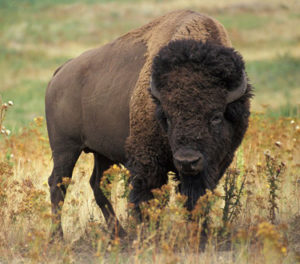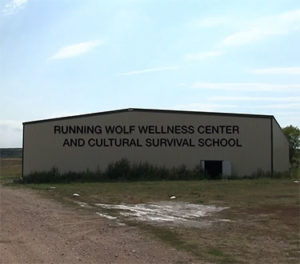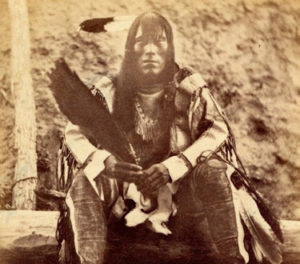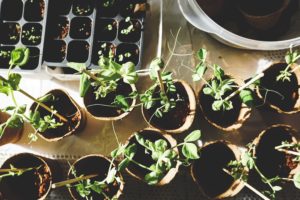
Medicine Lodge Confederacy Buffalo Project
The Arikara Creation Story starts from the beginning of the universe then continues through to the migration of the Arikara people from South America to present day North Dakota. The Arikara followed the voice of Mother Corn, which is the female aspect of the Creator, who directed them to go on a journey. When the Arikara came onto the plains they met the first buffalo. The Arikara have a story that specifically tells how the Arikara changed the buffalo and how the buffalo changed the Arikara. The story advises the Arikara how to use the Buffalo to sustain them on the plains physically and spiritually. When the Arikara butcher a buffalo these stories are retold to remind the people of this sacred relationship. The stories direct the people on how to butcher and what parts are never to be eaten and how to pray with the buffalo. The buffalo sustained the Arikara for the thousands of years while they lived on the plains before European contact. According to US Fish and Wildlife Service there was an estimate of 30,000 to 60,000 bison before European contact and by 1890 there were less than 1,000 buffalo. The Arikara have a high rate of illnesses for example diabetes and heart disease, which are directly related to the foods that are eaten today. The Medicine Lodge Confederacy Buffalo Project will reinstitute the teachings of the buffalo in order to bring back the physical and spiritual health to not only the Arikara but the land, ecosystem, animal life and the entire human family.
The buffalo are uniquely adapted to the plains environment and are naturally able to shelter through the harsh North Dakota winters as well as to calve without assistance from ranchers. The buffalo eat different grasses at different times which enhances the root system and helps to restore the ecosystem. This plant rotation actually promotes biodiversity of both plants and animals. The buffalo require less water then domestic cattle and they have less fat which gives them nutrient dense lean protein which is much healthier then cattle. This scientific information verifies what the Airkara have always known that there is a symbiotic relationship between the buffalo, people and the ecosystem.
The United States passed the National Bison Legacy Act May 9, 2016 which adopted the Bison as the National mammal of the United States. The Bison and Native American tribes are intrinsically connected. The bison were slaughtered in the 1860’s intentionally depriving Native Americans of their major food source. However Native American’s never forgot the buffalo and have passed down the stories to ensure that respect is given to them. There are many people and organizations who came together to bring back the buffalo and bring awareness to the benefits that they have to the ecosystem. The buffalo is represented in the stars and can bring great spiritual guidance to the human family. When the human family takes care of the buffalo, they will help to restore health to the world.

Running Wolf Cultural Survival Running School
Running Wolf Cultural Survival School was created by the Medicine Lodge Confederacy (MLC) in order to teach the Arikara world view, epistemology, and to revitalize the Arikara Language. The Running Wolf Cultural Survival School is built on the Running Wolf Ranch owned by Lee Voigt, a member of the Mandan Hidatsa Arikara(MHA) Nation. The name Running Wolf is his father Eugene Voigt’s Hidatsa name Zaysha Titiash. Eugene had the vision to purchase land and establish the 3,500 acre ranch.
North Dakota does not have a Charter School Law under which to incorporate. Charter School Laws include mechanisms that allow funding to flow into the school to meet needs of students in lieu of them attending Public Schools. Therefore, the Running Wolf School by necessity must be a Private School. It will begin by Parents organizing under the Home School laws of the State of North Dakota. However, because North Dakota does not have charter school laws, no money will flow to the school which is problematic and there is not money to pay for school operations, salaries, building maintenance, or utilities.
The MLC has developed a language community called “Strikes The Enemy”. They consist of parents and grandparents working together as a community to become fluent in Arikara and teach their children. They are all committed to learning the language while learning about the Arikara Creation Stories and mythologies which give the language meaning and context. The language community is committed to creating a dialect of Arikara that has been named the “Strikes The Enemy” dialect. This name reflects that many of the members are descendants of the Arikara sub-chief “Strikes The Enemy”. The kanaachitawiu (leader) in 2013 spent the year devising a 3,000 word dictionary transforming the Arikara polysynthetic language into an analytic language. The MLC has been meeting weekly refining and agreeing on the spelling and word transformations. This language community will launch a language nest with ten of their own children beginning in June, 2018. It has become apparent to members of the MLC that although they have a grasp of the language, they will never achieve true proficiency. The group spends about 90% of their efforts on activities related to Arikara survival and in doing so realize that a drastic change is needed in order to achieve fluent speakers.
The Medicine Lodge Confederacy evolved from a vision given to a young man who wanted something better for his Arikara people and the human family. He created a movement after he made and shared 260 songs in Arikara that addressed the meaning of life and the ancient teachings regarding the Arikara cosmology. The people who are learning and applying the teachings are members of the Medicine Lodge Confederacy. They are actively teaching their children and are creating a place for people to seek their purpose in life. This spiritual movement and the cosmology of Arikara has been renewed through the songs and prayer for the past nine (9) years. This movement gave a place for the language to be spoken and sung about. The Running Wolf Cultural Survival School is formally opening in June 2018. If you have any questions regarding helping the school or any of our other initiatives please contact us, we would greatly appreciate it.

Language Community
The MLC has developed a language community called “Strikes The Enemy”. They consist of parents and grandparents working together as a community to become fluent in Arikara and teach their children. They are all committed to learning the language while learning about the Arikara Creation Stories and mythologies which give the language meaning and context. The language community is committed to creating a dialect of Arikara that has been named the “Strikes The Enemy” dialect. This name reflects that many of the members are descendants of the Arikara sub-chief “Strikes The Enemy”. The kanaachitawiu (leader) in 2013 spent the year devising a 3,000 word dictionary transforming the Arikara polysynthetic language into an analytic language. The MLC has been meeting weekly refining and agreeing on the spelling and word transformations. This language community will launch a language nest with ten of their own children beginning in June, 2018. It has become apparent to members of the MLC that although they have a grasp of the language, they will never achieve true proficiency. The group spends about 90% of their efforts on activities related to Arikara survival and in doing so realize that a drastic change is needed in order to achieve fluent speakers.

Research Project Info
During the spring semester of 2016, three members of the MLC joined a collaborative effort, USDA funded, study between NHSC College and SDSU to observe, data collect, and identify native pollinators presents, timing and preferences comparatively of native juneberry and cultivated juneberry growths. This is a continuing five-year study, with two of the designated study sights being on the Running Wolf Ranch. The MLC plans to continue native pollinator promotion and habitat managements as part of school curriculums and future gardening projects.
Between the summers 2017 and 2018 members of the MLC have planted almost 500 trees of fruit bearing and culturally significant varieties. The fruit varieties are in conjunction with green house and food sovereignty plans, culturally significant varieties were selected to ensure local propagation and ready access to utilize in part with school projects and curriculum lessons.

